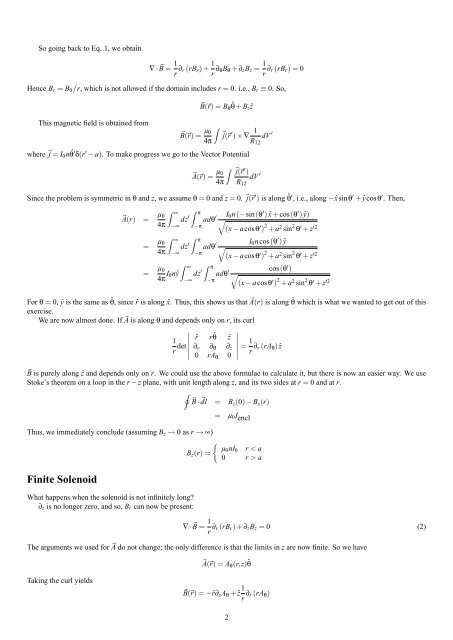You also want an ePaper? Increase the reach of your titles
YUMPU automatically turns print PDFs into web optimized ePapers that Google loves.
So go<strong>in</strong>g back to Eq. 1, we obta<strong>in</strong>∇ ·⃗B = 1 r ∂ r (rB r ) + 1 r ∂ θB θ + ∂ z B z = 1 r ∂ r (rB r ) = 0Hence B r = B 0/r, which is not allowed if the doma<strong>in</strong> <strong>in</strong>cludes r = 0. i.e., Br ≡ 0. So,This magnetic field is obta<strong>in</strong>ed from⃗B(⃗r) = µ Z04π⃗B(⃗r) = B θ ˆθ + B z ẑ⃗j(⃗r ′ ) × ∇ 1R 12dV ′where ⃗j = I 0 n ˆθ ′ δ(r ′ − a). To make progress we go to the Vector Potential⃗A(⃗r) = µ Z0 ⃗ j(⃗r ′ )dV ′4π R 12S<strong>in</strong>ce the problem is symmetric <strong>in</strong> θ and z, we assume θ = 0 and z = 0. ⃗j(⃗r ′ ) is along ˆθ ′ , i.e., along − ˆxs<strong>in</strong>θ ′ + ŷcosθ ′ . Then,⃗A(r) = µ Z ∞ Z π0dz ′ adθ ′ I 0 n(−s<strong>in</strong>(θ ′ ) ˆx + cos(θ ′ )ŷ)√4π −∞ −π(x − acosθ ′ ) 2 + a 2 s<strong>in</strong> 2 θ ′ + z ′2= µ Z ∞ Z π0dz ′ adθ ′ I 0 ncos(θ ′ )ŷ√4π −∞ −π(x − acosθ ′ ) 2 + a 2 s<strong>in</strong> 2 θ ′ + z ′2= µ Z ∞ Z π04π I 0nŷ dz ′ adθ ′ cos(θ ′ )√−∞ −π(x − acosθ ′ ) 2 + a 2 s<strong>in</strong> 2 θ ′ + z ′2For θ = 0, ŷ is the same as ˆθ, s<strong>in</strong>ce ˆr is along ˆx. Thus, this shows us that ⃗A(r) is along ˆθ which is what we wanted to get out of thisexercise.We are now almost done. If ⃗A is along θ and depends only on r, its curl∣ ∣∣∣∣∣1ˆr rˆθ ẑr det ∂ r ∂ θ ∂ z0 rA θ 0 ∣ = 1 r ∂ r (rA θ )ẑ⃗B is purely along ẑ and depends only on r. We could use the above formulae to calculate it, but there is now an easier way. We useStoke’s theorem on a loop <strong>in</strong> the r − z plane, with unit length along z, and its two sides at r = 0 and at r.I⃗B · ⃗dl = B z (0) − B z (r)= µ 0 I enclThus, we immediately conclude (assum<strong>in</strong>g B z → 0 as r → ∞){µ0 nIB z (r) = 0 r < a0 r > aF<strong>in</strong>ite SolenoidWhat happens when the <strong>solenoid</strong> is not <strong>in</strong>f<strong>in</strong>itely long?∂ z is no longer zero, and so, B r can now be present:∇ ·⃗B = 1 r ∂ r (rB r ) + ∂ z B z = 0 (2)The arguments we used for ⃗A do not change; the only difference is that the limits <strong>in</strong> z are now f<strong>in</strong>ite. So we have⃗A(⃗r) = A θ (r,z)ˆθTak<strong>in</strong>g the curl yields⃗B(⃗r) = −ˆr∂ z A θ + ẑ 1 r ∂ r (rA θ )2
















